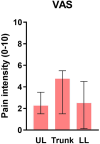Preserved tactile distance estimation despite body representation distortions in individuals with fibromyalgia
- PMID: 39119526
- PMCID: PMC11306202
- DOI: 10.3389/fpain.2024.1414927
Preserved tactile distance estimation despite body representation distortions in individuals with fibromyalgia
Abstract
Our mental representation of our body depends on integrating various sensory modalities, such as tactile information. In tactile distance estimation (TDE) tasks, participants must estimate the distance between two tactile tips applied to their skin. This measure of tactile perception has been linked to body representation assessments. Studies in individuals with fibromyalgia (FM), a chronic widespread pain syndrome, suggest the presence of body representation distortions and tactile alterations, but TDE has never been examined in this population. Twenty participants with FM and 24 pain-free controls performed a TDE task on three Body regions (upper limb, trunk, lower limb), in which they manually estimated the interstimuli distance on a tablet. TDE error, the absolute difference between the estimation and the interstimuli distance, was not different between the Groups, on any Body region. Drawings of their body as they felt it revealed clear and frequent distortions of body representation in the group with FM, compared to negligible perturbations in controls. This contrast between distorted body drawings and unaltered TDE suggests a preserved integration of tactile information but an altered integration of this information with other sensory modalities to generate a precise and accurate body representation. Future research should investigate the relative contribution of each sensory information and prior knowledge about the body in body representation in individuals with FM to shed light on the observed distortions.
Keywords: body image; body schema; chronic pain; multisensory integration; sensory weighting; tactile perception.
© 2024 Augière, Metral, Simoneau and Mercier.
Conflict of interest statement
The authors declare that the research was conducted in the absence of any commercial or financial relationships that could be construed as a potential conflict of interest.
Figures





Similar articles
-
Visuotactile integration in individuals with fibromyalgia.Front Hum Neurosci. 2024 May 17;18:1390609. doi: 10.3389/fnhum.2024.1390609. eCollection 2024. Front Hum Neurosci. 2024. PMID: 38826615 Free PMC article.
-
Tactile Detection in Fibromyalgia: A Systematic Review and a Meta-Analysis.Front Pain Res (Lausanne). 2021 Dec 24;2:740897. doi: 10.3389/fpain.2021.740897. eCollection 2021. Front Pain Res (Lausanne). 2021. PMID: 35295451 Free PMC article.
-
No Correlation between Distorted Body Representations Underlying Tactile Distance Perception and Position Sense.Front Hum Neurosci. 2016 Nov 21;10:593. doi: 10.3389/fnhum.2016.00593. eCollection 2016. Front Hum Neurosci. 2016. PMID: 27917118 Free PMC article.
-
Intact tactile anisotropy despite altered hand perception in complex regional pain syndrome: rethinking the role of the primary sensory cortex in tactile and perceptual dysfunction.PeerJ. 2021 May 3;9:e11156. doi: 10.7717/peerj.11156. eCollection 2021. PeerJ. 2021. PMID: 33986983 Free PMC article.
-
How our body influences our perception of the world.Front Psychol. 2015 Jun 12;6:819. doi: 10.3389/fpsyg.2015.00819. eCollection 2015. Front Psychol. 2015. PMID: 26124739 Free PMC article. Review.
References
-
- Gallagher S. Body image and body schema: a conceptual clarification. Source: the Journal of Mind and Behavior. (1986) 7(4):541–54.
-
- de Vignemont F, Pitron V, Alsmith AJT. What is the Body Schema? in: Body Schema and Body Image. New Directions. Oxford: Oxford University Press; (2021). p. 3–17.
-
- Paillard J. Body schema and body image - A double dissociation in deafferented patients. Mot Cont, Today Tom. (1999) 48(3):197–214. Available online at: http://www.ncbi.nlm.nih.gov/pubmed/21502132%5Cnhttp://scholar.google.com...
LinkOut - more resources
Full Text Sources

